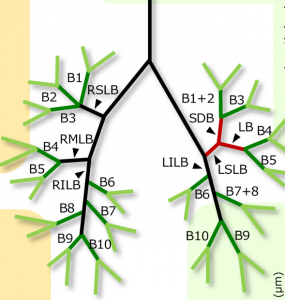
藤井さんの研究がPLoS One に受諾されました。
ヒトの気管支の分岐様式についてmonopodial(側方分岐)か dipodial(先端分岐)かについて、気管支の枝の長さを基本に解析し以下のことを見出した
- 中枢部の25気管支(葉気管支、区域気管支、亜区域気管支)形成は左上葉気管支から分岐する舌状気管支を除いて側方分岐による
- 葉気管支と区域気管支の分岐様式は、マウスの肺とヒトの肺で類似しているが、亜区域気管支においては異なっている
- 胚子期に気管支短縮などのリモデリングはみられない
Fujii S, Muranaka T, Matsubayashi J, Yamada S, Yoneyama A, Takakuwa T. Bronchial tree of the human embryo: categorization of the branching mode as monopodial and dipodial, PLoS One 2021, Published: January 15, 2021, https://doi.org/10.1371/journal.pone.0245558
Abstract
Some human organs are composed of bifurcated structures. Two simple branching modes—monopodial and dipodial—have been proposed. With monopodial branching, child branches extend from the sidewall of the parent branch. With dipodial branching, the tip of the bronchus bifurcates. However, the branching modes of the human bronchial tree have not been elucidated precisely. A total of 48 samples between Carnegie stage (CS) 15 and CS23 belonging to the Kyoto Collection were used to acquire imaging data with phase-contrast X-ray computed tomography. Bronchial trees of all samples were three-dimensionally reconstructed from the image data. We analyzed the lobar bronchus, segmental bronchus, and subsegmental bronchus. After calculating each bronchus length, we categorized the branching mode of the analyzed bronchi based on whether the parent bronchus was divided after generation of the analyzed bronchi. All lobar bronchi were formed with monopodial branching. Twenty-five bifurcations were analyzed to categorize the branching mode of the segmental and subsegmental bronchi; 22 bifurcations were categorized as monopodial branching, two bifurcations were not categorized as any branching pattern, and the only lingular bronchus that bifurcated from the left superior lobar bronchus was categorized as dipodial branching. The left superior lobar bronchus did not shorten during the period from CS17 or CS18, when the child branch was generated, to CS23. All analyzed bronchi that could be categorized, except for one, were categorized as monopodial branching. The branching modes of the lobar bronchus and segmental bronchus were similar in the mouse lung and human lung; however, the modes of the subsegmental bronchi were different. Furthermore, remodeling, such as shrinkage of the bronchus, was not observed during the analysis period. Our three-dimensional reconstructions allowed precise calculation of the bronchus length, thereby improving the knowledge of branching morphogenesis in the human embryonic lung.







